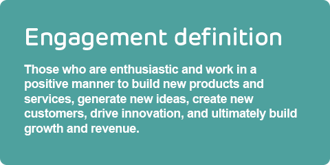The power of place explains how to develop an ecosystem of interconnected and interdependent spaces that support the physical, cognitive and emotional wellbeing of people in order to improve organisational performance.
In corporate boardrooms around the world, CEOs are recognising that employee engagement is a serious, bottom-line issue. We believe that place can help.
In 2013, Yahoo’s CEO, Marissa Mayer, catapulted the Power of Place into main stream media when she told her employees to go “back to work.” Regardless of your thoughts on her tenure as CEO, her decision to re-establish the office as Yahoo’s primary workplace was a strong signal to employees about her belief that people need to come together in physical space in order to do their best work, amplifying their own performance, as well as that of their organisation.
CEOs and leaders all around the world are agreeing with Mayer. Not because they don’t trust their employees, but because a new and increasingly disturbing issue is becoming top of mind for leaders around the world – that of employee engagement. Engagement leverages employees who are enthusiastic and work in a positive manner toward the growth of the company.
The impact of engagement
 The impact of engagement has been proven in numerous studies by multiple parties. For instance, a 2013 survey conducted by Gallup showed that organizations with highly engaged employees consistently outperform their competition. These companies bounced back from the recession faster and experience as much as 147% increase in earnings per share.
The impact of engagement has been proven in numerous studies by multiple parties. For instance, a 2013 survey conducted by Gallup showed that organizations with highly engaged employees consistently outperform their competition. These companies bounced back from the recession faster and experience as much as 147% increase in earnings per share.
In the report, the top quartile of companies with engaged workforces vs. the bottom quartile also experienced higher productivity, higher profitability, lower turnover, less absenteeism and fewer safety accidents.
- 22% higher profitability
- 21% higher productivity
- 25% lower turnover in high turnover companies and 65% lower turnover in low turnover companies
- 48% less safety incidents
The cost of disengagement

Disengagement costs the UK £52-£70 Billion per year in lost productivity.
And yet, despite the importance of employee engagement to overall organisational performance, 83% of employees in the UK are “not engaged” or “actively disengaged” at work. That means just a small minority of employees are deeply focused on creating value for their organisation.
And that’s why engagement is such a serious issue. It’s also why it’s so critical to bring employees together.
Disengagement costs the UK £52-£70 Billion per year in lost productivity.
We know that place alone cannot achieve a business’ engagement goals or create alignment with its purpose, but we also believe leaders would be remiss to ignore place completely.
Creating the right work environment can make a difference
Creating the right work environment can make a difference. Steelcase global research shows a correlation between how people feel about their workplace and their degree of engagement. In other words, employees that feel good about their workplace are also more engaged. When you look at those that are highly dissatisfied with their workplace, they also have very low engagement.
.jpeg?width=300&height=173&name=download%20(1).jpeg) CEOs know that while work can happen anywhere, because of our portable devices, when you bring People with a strong sense of Purpose together in a Place where they can thrive, that’s the first step towards building engagement.
CEOs know that while work can happen anywhere, because of our portable devices, when you bring People with a strong sense of Purpose together in a Place where they can thrive, that’s the first step towards building engagement.
Steelcase global research shows a correlation between how people feel about their workplace and their degree of engagement.
People + Purpose + Place = Engagement
We believe place can help, and as we work with the leading organisations around the world we believe that an "office renaissance" is occurring. These organisations know they need to bring their people together, but also know it needs to be in a place that does something different than what it's done in the past.
New evidence suggests a connection between how people feel and how they perform. We understand that when people can come together with a shared purpose in a place that delivers not only what they want, but the things they need, it can activate engagement by enhancing their physical, cognitive and emotional wellbeing.
Power of place
We use our insights to create workplaces that support engagement and wellbeing to increase organisational performance. These places must be destinations designed to augment human interaction. Users must have choice and control over where and how they work, and a palette of places to choose from, including a palette of posture, presence and privacy.
We help leading organisations rethink how they use place, and instead of creating offices, help them create an ECOSYSTEM of interconnected and interdependent places that support the physical, cognitive and emotional needs of people. Only by doing this can your workspace help to increase engagement.
Contact us to find out more about the power of place.


